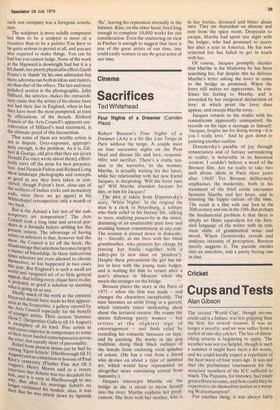Art
Clique-claque
John McEwen
The 'Hayward Annual 1979' (Hayward Gallery till 27 August) is the third since the series was inaugurated, selected, as before, by artists, five of them this time, each with a responsibility to choose the 'best' work of the moment in their particular field as he, and in one ease she, sees it. Accordingly there are sections devoted to abstract and figurative painting, sculpture, photography and, to be held at various dates and times during the run of the show, performances. Some of the props and backdrops for the • last category are permanently installed to quite dramatic effect, but it is the conclusive artbbjects that are discussed here.
The intention of inviting five 'younger' (that is, thirtyish; everyone stays younger longer in the art world) artists to select on this occasion was obviously in the hope that they would uncover new young talent. In the event it would seem that they had a job mustering even the numbers required to fill the infamous artcraft carrier. Comparative youth there certainly is; talent only in the hands of a few old campaigners, newly middle-aged though some of them may be. In the painting sections the figurative work of the oldest participants of all, Leon Kossoff and Euan Uglow, is classes apart from the rest, and Uglow's a class apart again. Both, of course, are comparatively and correctly famous, so their predominance in such raw company was a foregone conclusion.
The sculpture is more solidly competent but then to be a sculptor is more of a vocation than to be a painter.You have to be quite serious to persist at all, and you are also required to make things. You can be bad but you cannot fudge. None of the work at the Hayward is downright bad but it is a bit dumb;too purely physicalin effect.Garth Evans's is 'dumb' by his own admission but more adventurous both in ideas and materials than that of the others. The last and most Polished section is the photographic. John Hilliard, the selector, makes the extraordinary claim that the artists of his choice have not had their due in England, when in fact they have been the most pampered, at least by officialdom, of the decade. Richard Francis of the Arts Council's apparent corroboration of Hilliard's mad statement, is the ultimate proof of this favouritism. That some of them are worthy artists is not in dispute. Over-exposure, appropriately enough, is the problem. As it is, Gilbert & George, old pros that they are (even Donald Zec once wrote about them), effortlessly carry off the prize for best presentation. And Hamish Fulton and Richard Long Show landscape photographs and concepts as good as any they have taken or conceived, though Fulton's best, close-ups of the surfaces of Indian rocks and monastery Walls, were (here we go again) in his Whitechapel retrospective only a month or two back.
But is the Annual a fair test of the con temporary art temperature? The Arts Council took a long time and several potshots at a formula before settling for the present system. The advantage of having artists as selectors is that, however bad the Show, the Council is let off the hook; the disadvantage that selection becomes largely a matter of friendship. In these indecorous times selectors are even allowed to choose themselves as has happened in two cases _nInis Year. But England's is such a small art world and vanguard art of so little general _p Peal, that letting every clique have its day ,„is, is as good a solution to showing What s going on as any. Ideally much of the work at the eminent Hayward should have made its first appearance at the Serpentine, a gallery opened by the Arts Council es ciall for the benefit Younger artists. Pe rtists. Their current 'Summer 2, rtists. Their current 'Summer 2, Show (Serpentine Gallery till 19 August) Is exemplary of its kind. Five artists in mid-career superior in competence to some of their more d the river, but equallycsohnotetmporariesacross Rl* ef from i f ersonality. e visiting 'P present issues can be had by 'Egon Schiele' August) and an exhis" • Au (Marlborough till 31 Klee 's in honour of Paul c)entenary (Fischer Fine Art till 3 August) that Henry Moore said in a recent him, and it is Sc tele was too decadent for Why. But after at Marlborough to see r is marriage Schiele no longer victimised his marriage models. Alas, it was then that he was struck down by Spanish 'flu', leaving his reputation eternally in the balance. Klee, on the other hand, lived long enough to complete 10,000 works for our consideration. Even the smattering on view at Fischer is enough to suggest that here is one of the great artists of our time, one could easily venture to say the great artist of our time,







































 Previous page
Previous page